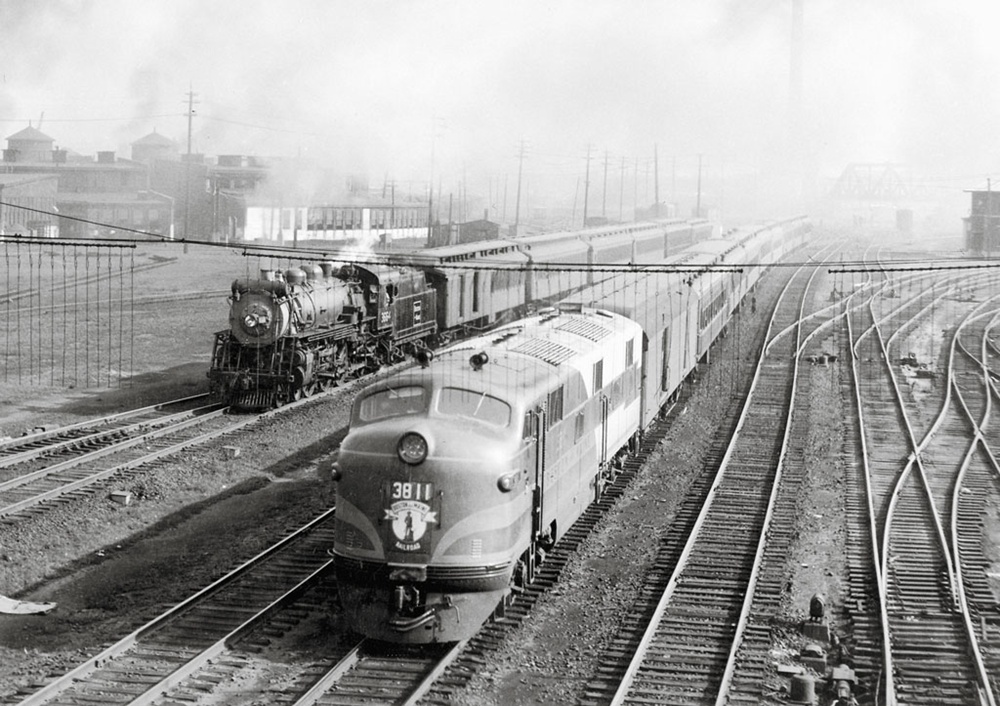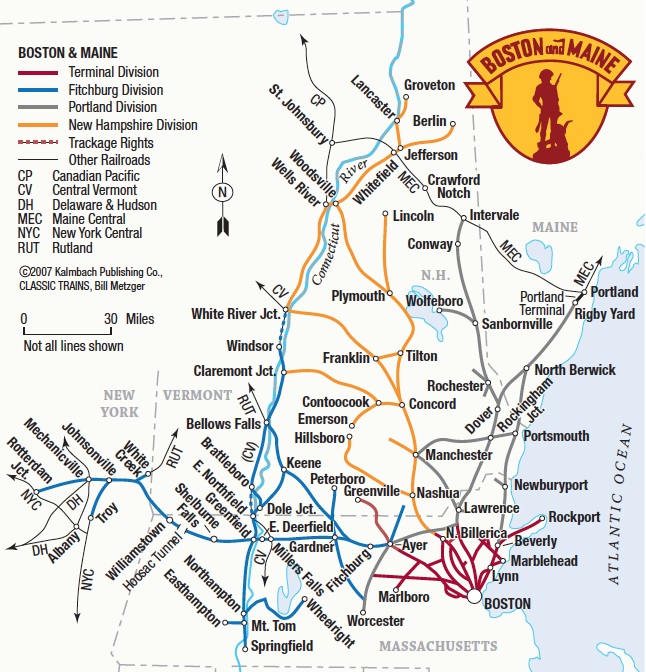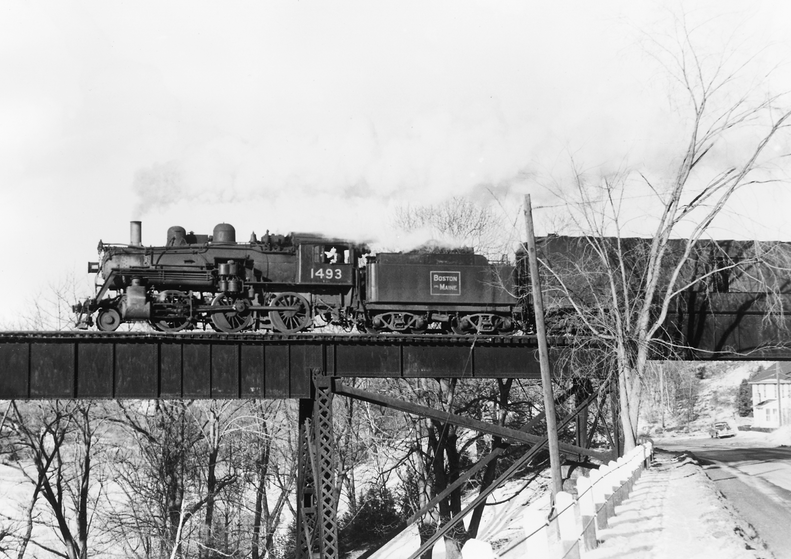The history and major events of B&M
For 150 years the Boston & Maine Railroad was an integral part of northern New England, beginning with the charter on March 15, 1833, for the Andover & Wilmington Railroad to build between those two adjacent towns northwest of Boston. The name arose with the creation of the Boston & Maine Railroad of New Hampshire on June 27, 1835.
Railway Mania
The B&M had become a regional force in the 1870s, gaining the upper hand in the consolidation battles that followed New England’s “railroad fever” expansion in the 1840s to 1860s. B&M in 1885 leased the Eastern Railroad, which included a controlling block of Maine Central stock, and gained control of the Boston & Lowell in 1887. The Concord & Montreal capitulated in 1895, and the Fitchburg Railroad came into the fold in 1900. The Fitchburg brought with it the landmark, 4.75-mile Hoosac Tunnel through the Berkshires, longest railroad bore in the United States when it opened in 1875 after a 24-year construction. Ultimately, more than 173 companies were melded into the B&M system.
Boston & Maine’s apogee of power, territory, and influence occurred from 1907 to 1916, when more than 25,000 employees kept the 2,364-mile system fluid and profitable. In all of New England, only the New York, New Haven & Hartford Railroad exceeded the B&M in power and influence.
B&M Railroad Roster
B&M’s early 20th-century locomotive roster was heavy on 0-6-0s (192), 2-6-0 Mogul-type locomotives (137), 2-8-0 Consolidation-types (245), and 4-4-0 American-types (91), but it had nary a 2-8-2 Mikado. It did have oddities. In 1910, B&M received four oil-fired 2-6-6-2 Mallets for use through Hoosac Tunnel. They were replaced in 1911 by electric locomotives and sold to Maine Central, which used them as pushers up Crawford Notch in New Hampshire. Alco built 90 4-6-2 Pacific-type locomotives for B&M varnish in the 1910s, although the trains — the likes of the Minute Man, Alouette, Red Wing, and Flying Yankee — weren’t given those names until at least 1925.
In 1913, B&M opened a central locomotive shop in North Billerica, Mass., five miles south of Lowell.
Filing for Bankruptcy
As with most railroads in the century’s early decades, there were ups and downs. B&M entered bankruptcy in August 1916, and the subsequent 1919 reorganization eliminated most of its numerous leases. The last half of the 1920s was difficult. A major flood in 1927 washed away or damaged hundreds of miles of track and disrupted service for days, but it allowed B&M to begin its first major abandonment of branch lines, already made unprofitable by Ford’s Model T and paved roads.
Capital investment in the main line and physical plant in the late 1920s included strengthened bridges, rock ballast, heavier rail, and centralized traffic control signaling installations. B&M built hump yards at Mechanicville, N.Y., and East Deerfield and Somerville, Mass., in suburban Boston. In central Boston, a new complex was built that included North Station/Boston Garden, the Hotel Manger, the Industrial Building (B&M’s headquarters), an engine terminal, and the Charles River drawbridges.
Dieselisation
A new administration, led by Edward S. French, took over in 1930 and soon put the B&M on the path to dieselization. The earliest splash was the three-car streamliner Flying Yankee, delivered by Budd on February 9, 1935. A clone of Burlington’s first Zephyr, the “first Streamliner east of the Mississippi” served on several B&M routes over the years and carried several train names before retirement in 1957 and eventual preservation.
A decade before, B&M tiptoed past steam locomotives in passenger service with 13 Electro-Motive Corp./Winton gas-electric railcars. Coincident with the Budd streamliner in 1935, B&M acquired diesel switchers from Ingersoll-Rand/Westinghouse and Alco-GE, plus two diesel-powered baggage-Railway Post Office locomotives from St. Louis Car Co. More EMC and Alco switchers followed between 1936 and 1939.
In 1943 to 1944 the Office of Defense Management allotted the B&M 12 four-unit EMD FT freight diesel-electric locomotives, and in October 1945, two E7A passenger units introduced the new maroon-and-gold “Minute Man” color scheme. The balance of 14 E7s, three F2A-B passenger duos, and 15 F2As (to make A-B-A consists with an FT A-B) allowed B&M to de-energize the Hoosac Tunnel electric zone in 1946, the first steam-road electrification to shut down. B&M in 1947 said it was 70% dieselized.
Edward French’s administration had conceived an economy plan to combine senior executive positions with the Maine Central in 1932. The roads were “jointly managed” but not merged. The closest coordination during those years came near the end of World War II, when one purchase order to EMD covered 20 E7As, the only combined order B&M-MEC ever placed.
French retired in 1952, and a proxy fight at the 1955 Annual Meeting deposed his administration — which had not declared a dividend since 1932 — and created a new 19-member board of directors. All were allied with Patrick B. McGinnis, a Wall Street promoter. The new board cancelled the last B&M-MEC corporate relationship in 1955, and on Jan. 20, 1956, McGinnis became B&M president, about 6 hours after resigning as New Haven’s president.
He came to a railroad about to finish its motive-power transformation. Following a trial with Alco’s RS2 road-switcher, B&M bought 36 RS2s and RS3s from 1948 to 1955. Four BL2s from EMD in 1948 were followed by 23 GP7s from 1950 to 1953.
A big change was also on tap for B&M passenger service, kicked off by an order in 1951 for three Budd Rail Diesel Cars. B&M called the self-propelled cars Highliners, and by 1957 had purchased 109, the largest RDC fleet. B&M stopped using steam locomotives in commuter service on July 23, 1956, and the last gas-electrics also departed that year.
By 1958, RDCs were covering nearly all passenger service. On Jan. 20, service on the Fitchburg Division west of Williamstown, the last stop in Massachusetts, was terminated. The railroad changed its paint scheme, trading-in to EMD in 1956 to 1957 its 48 FTs for 50 EMD-build GP9 diesel-electric locomotives, which arrived in McGinnis’ new blue, black, and white livery and were soon called Bluebirds. Six GP18 locomotives that followed in 1961 were B&M’s last pre-1970-bankruptcy power.
By 1960, New England freight business had slumped as heavy industry was departing the region. B&M abandoned lines, reduced double-track main lines to CTC-controlled single track, and sold buildings and land in large proportions. Still, losses mounted, and employment plummeted. McGinnis and his successor, Daniel A. Benson, were convicted and jailed in 1966 for financial improprieties.
B&M filed for bankruptcy again on March 12, 1970. Late that year the trustees hired the “doctor of sick railroads,” John W. Barriger III, as president effective Jan. 1, 1971. “JWB” promptly began to assemble a new operating and management team of young, bright professionals. Not so coincidentally, that September the Boston & Maine Railroad Historical Society, one of the first such railroad special-interest groups, was incorporated.
Pan Am Railways
Paul W. Cherington, a Harvard Business School professor, took B&M’s helm in January 1973, and that year F. C. “Buck” Dumaine, head of Amoskeag Corp., purchased a sufficient number of B&M’s in-default first mortgage bonds to make him B&M’s de facto owner — subject only to the bankruptcy court trustees and judge. Dumaine sent his Executive Assistant, Alan G. “Dusty” Dustin, to the B&M to assist Dr. Cherington.
Dustin became B&M president and CEO in Aug. 1974, and he and his young managers turned the railroad around in the face of declining revenue and carloads. They kept it from liquidation and out of Conrail in 1976, sold enough assets at high enough prices to keep creditors at bay, and managed to rebuild the road’s motive power, rolling stock, trackage, and signal system.
In 1981, Timothy Mellon, scion of the Pittsburgh banking family, purchased the Maine Central, and on June 30, 1983, his privately held Guilford Transportation Industries (named for the Connecticut city where the offices were) added the B&M, for $24.3 million. B&M’s independence was over, but “Boston & Maine” still remains on locomotives and freight cars of what in 2006 Guilford “re-branded” as Pan Am Railways.

















As I grew up in New York State before moving to California in 1973, and my very first railroad job was with America’s very first railroad (the B&O), I am particularly interested in your “Fallen Flag” articles! Please continue the series!
Never knew much about this road, as never came to St. Louis, do remember seeing a stray boxcar at times. Barringer is a big local name, his collection is at UMSL.
Although the Andover and Wilmington RR is long gone, one of its buildings still survives in North Andover which was still part of Andover when the railroad was built. It is apparently unclear whether this was a station, freight house, or railroad offices. The building can be seen on Google Street View here: https://www.google.com/maps/@42.7061164,-71.1331898,3a,90y,77.19h,82.72t/data=!3m6!1e1!3m4!1sqhIBeWxacW9Vtb23MoFlpw!2e0!7i13312!8i6656